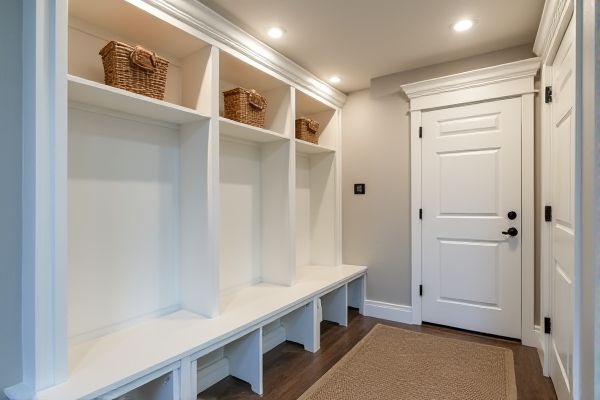
Open cubbies in a mudroom offer easy access and visibility, making it simple to grab shoes and coats quickly, while closed cubbies provide a tidier appearance by hiding clutter and protecting belongings from dust. Considering your storage needs and aesthetic preferences can help determine the best option for your space--read on to explore the pros and cons of both styles.
Table of Comparison
| Feature | Open Cubbies | Closed Cubbies |
|---|---|---|
| Accessibility | Easy and quick to access items | Requires opening doors for access |
| Visibility | Items in plain sight, easy to locate | Items hidden, reduces visual clutter |
| Organization | Requires consistent tidiness to avoid mess | Encourages organized storage inside compartments |
| Dust Protection | Exposed to dust and dirt | Protects contents from dust and dirt |
| Design Style | Casual, open, and airy look | Clean, streamlined, and polished appearance |
| Maintenance | Regular cleaning required to maintain neatness | Less frequent cleaning due to enclosed storage |
| Cost | Generally more affordable to build or buy | Typically higher cost due to doors and hardware |
Introduction to Mudroom Cubbies
Mudroom cubbies provide essential storage solutions, helping organize shoes, coats, and personal items efficiently. Open cubbies offer easy access and visibility, making it simple to grab your belongings quickly. Closed cubbies protect items from dust and create a cleaner, more streamlined appearance in your mudroom.
What Are Open Mudroom Cubbies?
Open mudroom cubbies offer easy access and visibility for storing daily essentials like shoes, bags, and jackets, promoting quick organization and retrieval. Unlike closed cubbies, open designs lack doors or lids, maximizing airflow and reducing clutter buildup, which helps keep your mudroom fresh and tidy. Choosing open cubbies suits busy households where convenience and immediate access to items enhance daily routines.
What Are Closed Mudroom Cubbies?
Closed mudroom cubbies are storage compartments with doors or panels that conceal belongings, providing a tidier and more organized appearance. They protect items from dust and clutter, making them ideal for storing shoes, coats, and personal accessories securely. These cubbies are preferred in homes prioritizing a clean aesthetic and privacy for stored items in entryways or mudrooms.
Pros of Open Mudroom Cubbies
Open mudroom cubbies offer quick and easy access to shoes, bags, and daily essentials, making your routine more efficient. Their visibility encourages organization and cleanliness while adding an airy, spacious feel to the mudroom. With no doors or covers, open cubbies maximize convenience and reduce the hassle of constantly opening and closing compartments.
Cons of Open Mudroom Cubbies
Open mudroom cubbies can lead to clutter accumulation, as items are constantly exposed and lack concealment, which may disrupt the overall aesthetic of the space. They offer limited protection against dust and dirt, requiring frequent cleaning to maintain organization and hygiene. Privacy is compromised, and personal belongings are more vulnerable to damage or loss compared to closed cubbies.
Advantages of Closed Mudroom Cubbies
Closed mudroom cubbies offer enhanced organization by concealing clutter and providing a cleaner, more streamlined appearance. They protect stored items from dust, dirt, and pet hair, extending the lifespan of shoes, jackets, and accessories. Increased privacy and security for personal belongings make closed cubbies ideal for busy households seeking a tidy, functional entryway solution.
Drawbacks of Closed Mudroom Cubbies
Closed mudroom cubbies can limit airflow, leading to the buildup of odors and moisture, especially in damp environments where shoes and outerwear are stored. The enclosed design often requires more maintenance to keep surfaces clean and free of dust or mold. Limited visibility inside closed cubbies can make it difficult to quickly locate items, reducing convenience and accessibility.
Organization and Accessibility: Open vs Closed
Open cubbies in mudrooms enhance accessibility by allowing quick visibility and easy reach of items like shoes, bags, and coats, promoting efficient daily routines. Closed cubbies provide a tidier appearance by concealing clutter, protecting belongings from dust, and offering a more organized storage solution for personal items. Choosing between open and closed cubbies depends on the balance between immediate access and maintaining a clean, streamlined mudroom aesthetic.
Style and Aesthetic Considerations
Open cubbies in mudrooms create an airy, accessible look that enhances a casual, farmhouse, or modern style by showcasing neatly organized items and personal decor. Closed cubbies offer a sleek, streamlined appearance ideal for minimalist or contemporary designs, concealing clutter and maintaining a tidy visual flow. Choosing between open and closed cubbies depends on the desired balance between decorative display and visual uniformity in the overall mudroom aesthetic.
Which Mudroom Cubby Style is Best for You?
Open cubbies in mudrooms offer easy access and increased visibility, making them ideal for busy households needing quick storage for shoes, bags, and coats. Closed cubbies provide a cleaner, more organized appearance by concealing clutter and protecting items from dust, perfect for those prioritizing aesthetics and tidiness. Choosing between open and closed cubbies depends on your lifestyle, storage needs, and design preferences within your entryway space.
 homyna.com
homyna.com